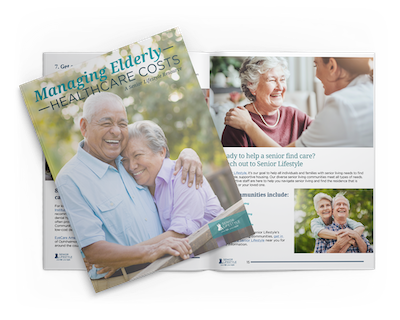When I talk with older adults, they tell me that the number-one thing they lose sleep over is the fear of running out of money.
In particular, older adults worry about the cost of healthcare, including paying for help with managing activities of daily living (ADLs) and potential custodial care. They worry for good reason, and the situation will get worse as baby boomers age. Recent studies indicate that fewer than two-thirds of those approaching retirement age have any retirement savings at all, and the vast majority of those who do have saved less than $10,000. Fewer older adults have (or will begin to receive) payments from pensions than in the past. Economic volatility, the very low rate of retirement savings, and longer life expectancy is a recipe for disaster.

Download The Complete Guide to Managing Elderly Healthcare Costs
One of the most impactful considerations for a senior’s quality of life is healthcare costs. Read our eBook, “The Complete Guide to Managing Elderly Healthcare Costs” for the financial insights you need to help you make an informed decision.
Download the GuidePlan Early
Plans for coordinating and paying for future care needs should be initiated early on, ideally by people when they are in their forties and fifties. Why so soon? Because, as with so many other aspects of planning, the sooner you plan, the more time you have to implement your plans and the more options that are available to you. For example, the cost of long-term-care insurance premiums are lower the younger you are, assuming your health is good. As time goes on, it is more likely that premiums will be higher due to your age or health conditions, or you might even be uninsurable.
For some families, the issue may be about planning to protect assets for use by the “well spouse” in the event that one spouse requires long-term medical care. Since Medicaid has a five-year look back period, it is important to do such planning well before the care is actually needed.
How it adds up
Consider this scenario: You are sixty-five years old and newly eligible for Medicare. Based on actuarial statistics, you can expect to live for at least another twenty years. I advise my clients to plan for another twenty-five or thirty years. What does this mean in terms of dollars and cents? For one thing, you will need to plan to pay for your Medicare Part B premiums, your supplemental insurance premiums (if you carry this insurance) and/or any deductibles and coinsurance, your Part D prescription drug plan and your coinsurance, and services not covered by Medicare (such as hearing aids, vision services, etc.). On top of that, you need to plan for care. What does all this add up to? In today’s dollars, you will spend:
– Approximately $1,200 per year on Medicare Part B premiums.
– Approximately $2,400 per year for a Plan F Supplemental Insurance premium (and possibly more, depending on your age at enrollment and the part of the country you live in).
– Approximately $500 per year for a Part D prescription drug plan premium.
– A typical $2,500 per year on uncovered services, deductibles, coinsurance, and copays.
This adds up to about $6,600 per person per year. On top of this, long-term care on the average will cost in the neighborhood of $125,000 in today’s dollars. And it could be more if you require extensive home care. Total this up, and you are looking at $6,600 a year for thirty years, or well over $300,000 per person in today’s dollars. That means a typical couple needs to have set aside at least $600,000 in an investment that will keep up with the rate of health care inflation by the time they reach Medicare age. This is, of course, on top of the funds that will be required for all other living expenses. I hope you can see why beginning to plan early makes sense!
Sheri Samotin is President of LifeBridge Solutions and author of Facing the Finish: A Road Map for Aging Parents and Adult Children. She is also the California State Coordinator for Eldercare Matters. Sheri provides daily money management services; individual coaching; and online, on-demand coaching programs on this topic to her clients.
Disclaimer: All opinions expressed by Sheri Samotin on this website are solely her opinions and do not necessarily reflect the opinions of Senior Lifestyle Corporation. You should not treat any opinion expressed by Sheri Samotin as a specific inducement to make a particular investment or follow a particular strategy, but only as an expression of her opinion.


